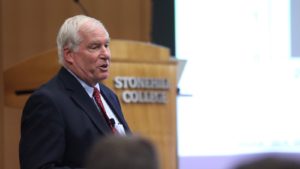The head of the Federal Reserve Bank of Boston is not as optimistic about what’s to come for the national economy as other monetary policymakers and he says it’s due to his concern about a second surge of COVID-19 cases, the absence of additional financial aid from Congress, and an expectation that impacts of the pandemic will spill over from one sector to others.
“The biggest challenge to the economy, and the risk to a more optimistic forecast, continues to be our inability in the U.S. to achieve the public health progress on the virus seen in many other developed countries,” Federal Reserve Bank of Boston President and CEO Eric Rosengren said Wednesday in a speech to the Boston Economic Club. “A full recovery probably requires the availability of vaccines and more effective treatments for the virus because until then, many businesses and households are unlikely to return to more normal spending habits.”
The median estimate among the Fed’s Federal Open Market Committee projects the economy will grow by 4 percent in 2021, following a drop of 3.7 percent this year. The median estimate suggests the national unemployment rate will fall to 7.6 percent by the end of this year and to 5.5 percent by the end of 2021. Rosengren said he expects the economy to recover, but more gradually than his peers.
“I certainly hope that this less optimistic outlook turns out to be wrong. But the likelihood that this view is right is why I believe additional fiscal stimulus, and continued monetary stimulus, remain necessary – despite some of the encouraging economic data received over the summer,” he said, though he did not provide his own forecast in his remarks Wednesday.
Driving Rosengren’s relative pessimism is his assumption that “individuals and firms still being constrained significantly by community spread of the virus this fall and winter.”
At the state level, Gov. Charlie Baker last week began urging Massachusetts residents to get a flu shot now so as to not overwhelm the hospital system this fall or winter in the event of “a potential second surge associated with COVID.”
“I am concerned that a second wave of COVID-19 infections this fall and winter is likely, which could cause some states to impose new restrictions on mobility and face-to-face interactions. Even without added restrictions, the added risk of infection from a second wave could sap some of the willingness of consumers and businesses to spend and invest,” Rosengren said.
Rosengren said policy actions like the creation of the Paycheck Protection Program or programs like the Fed’s Main Street Lending Program are “probably the more effective tool at this time” for perpetuating the recovery since money can be directly allocated to businesses most impacted by COVID-19 without requiring them to take on additional debt.
The Boston Fed chief acknowledged that signals from the national economy were “better than expected” over the summer because many states reopened from pandemic shutdowns “relatively quickly” and the increase in personal mobility fueled economic activity.
“Unfortunately, we are also seeing the costs of higher mobility on public health outcomes, as infections and deaths from COVID-19 remain elevated,” he said.
Also Wednesday, one of Rosengren’s peers gave a speech to the Institute of International Bankers in which he said he expects that “robust GDP growth over the rest of this year and in 2021 will lead to strong employment gains.” Randal Quarles, vice chair for supervision of the Federal Reserve Board of Governors, said he thinks improvements in testing, tracing, treatment and a better understanding of how to mitigate risks will allow businesses to avoid the same kind of damage they sustained in the spring if there is a second surge this fall.
“The COVID event was an enormous economic shock in the first half of 2020, but a recovery is underway, and the world seems to be adjusting in ways that allow us to address public concerns about the virus without sudden stops in economic activity,” Quarles said in his remarks. “A full recovery is still a good way off, however, and risks remain weighted to the downside. Policymakers will need to remain vigilant.”







